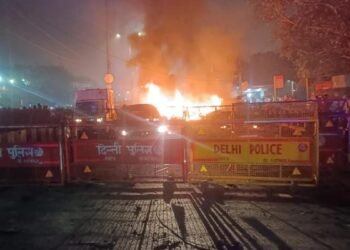Despite labeling India’s pre-dawn operation as an “act of war,” Pakistan’s actual response has been limited, avoiding airspace violations and opening a door for potential dialogue. International calls for restraint appear to be making an impact.
New Delhi/Islamabad, May 7, 2025
In a surprising turn of events, both India and Pakistan have signaled a desire to avoid further escalation following India’s pre-dawn air strikes on nine alleged terrorist sites in Pakistan and Pakistan-occupied Jammu and Kashmir (PoJK). The strikes, codenamed “Operation Sindoor,” were launched in retaliation for the April 22 Pahalgam terror attack that killed 26 civilians, mostly tourists, in Indian-administered Kashmir. Despite initial fears of a spiraling conflict between the nuclear-armed neighbors, both nations have issued statements and actions suggesting a cautious approach to de-escalation.
India’s Ministry of Defence described Operation Sindoor as a “focused, measured, and non-escalatory” operation, emphasizing that no Pakistani military or civilian installations were targeted. The strikes, executed by the Indian Army, Navy, and Air Force using precision-guided munitions and kamikaze drones, hit terror camps linked to groups like Jaish-e-Mohammed (JeM) and Lashkar-e-Taiba (LeT) in locations including Bahawalpur, Muridke, Sialkot, Kotli, and Muzaffarabad. Indian officials, including Foreign Minister S. Jaishankar, underscored a zero-tolerance policy for terrorism while clarifying that the strikes were not intended to provoke a broader conflict.
National Security Advisor Ajit Doval reportedly briefed his U.S. counterpart and Secretary of State Marco Rubio shortly after the strikes, reinforcing India’s intent to limit the scope of the operation. Prime Minister Narendra Modi, who monitored the strikes through the night, has not issued public statements calling for further action, suggesting New Delhi’s preference for containment.
#Pakistan Defence Minister Khawaja Asif told Bloomberg TV that Islamabad had maintained over the past two weeks that it would not initiate hostile actions against India.https://t.co/XllZidjMgs
“If India backs down, we will definitely wrap up this tension.” pic.twitter.com/NNqwnfE078
— Scroll.in (@scroll_in) May 7, 2025
ALSO READ: Masood Azhar Confirms Death of 10 Kin in Airstrikes, Calls It a ‘Blessing’
Pakistan’s Response: Rhetoric Meets Restraint
Pakistan’s initial reaction was sharp, with Prime Minister Shehbaz Sharif labeling the strikes an “act of war” and vowing a “befitting reply.” The Pakistani military claimed to have shot down five Indian jets and a drone, though India’s government and fact-checkers debunked these claims, asserting that no jets violated Pakistani airspace and that missiles were fired from Indian territory.
Despite the heated rhetoric, Pakistan’s actions have been relatively restrained. The Pakistani Army confirmed that Indian strikes did not involve airspace violations, reducing the likelihood of immediate retaliatory airstrikes. Defense Minister Khawaja Asif, in a notable softening of tone, told GeoTV that Pakistan would be open to dialogue if tensions subsided, a statement echoed by posts on X suggesting a willingness to de-escalate.
“ INDIA HAS DISPLAYED CONSIDERABLE RESTRAINT IN ITS RESPONSE 🙂✌️
HOWEVER…..
INDIAN ARMED FORCES ARE FULLY PREPARED TO RESPOND TO PAKISTANI MISADVENTURES, IF ANY, THAT WILL ESCALATE THIS SITUATION 💪😎
JAI HIND 🫡🇮🇳 ”
❤️🔥 pic.twitter.com/0YKWS963zH
— Nationalist Mumbaikar 🇮🇳™ (@Ayush_Shah_25) May 7, 2025
Pakistan’s response has largely been limited to artillery fire along the Line of Control (LoC), which killed three civilians and injured others in Jammu and Kashmir. While this marks the 13th consecutive day of ceasefire violations, the scale of retaliation has not matched the intensity of past conflicts. Pakistan also closed its airspace for 48 hours and conducted missile tests, but these appear to be symbolic gestures rather than precursors to major military action.
ALSO READ: India Deploys SCALP Missiles, Hammer Bombs in Precision Strikes
International Mediation and Domestic Pressures
The international community has played a significant role in urging restraint. U.S. Secretary of State Marco Rubio, UN Secretary-General Antonio Guterres, and leaders from China, Russia, France, and the UAE have called for both nations to avoid escalation and keep communication lines open. President Donald Trump expressed hope that the situation would “end quickly,” while a UN team arrived in Pakistani Kashmir to assess the situation.
Domestically, both countries face pressures that may be driving their cautious approach. In India, public sentiment, as seen in statements from citizens like Delhi lawyer Kumar Ravi Shankar, supports the strikes as a necessary response to terrorism but does not appear to demand further aggression. Opposition leaders like Congress’s Shashi Tharoor have praised the operation while advocating for restraint to prevent “uncontrolled escalation.”
In Pakistan, the military and government must balance public outrage with the economic and political realities of a prolonged conflict. The country’s stock market saw a sharp decline of 5.78% at the opening but later recovered, indicating market sensitivity to escalation risks. The closure of schools in Punjab and Islamabad and disruptions to air travel reflect domestic concerns, but the absence of large-scale military mobilization suggests a desire to avoid a full-blown crisis.
A History of Controlled Escalation
This is not the first time India and Pakistan have navigated a delicate balance after military action. The 2016 surgical strikes following the Uri attack and the 2019 Balakot airstrikes after the Pulwama bombing both saw tit-for-tat responses that eventually de-escalated. Analysts note that the current situation, while severe, follows a similar pattern, with both sides calibrating their actions to satisfy domestic audiences while avoiding a broader conflict. The fact that India reportedly attempted to communicate its non-escalatory intent through Iran, though the message was not conveyed, further indicates a preference for de-escalation.
While the situation remains volatile, several factors suggest that neither India nor Pakistan is eager to escalate further. India’s emphasis on targeting only terror infrastructure, combined with Pakistan’s measured military response and openness to dialogue, points to a mutual interest in containing the crisis. The international community’s active engagement and the economic and social costs of prolonged conflict are likely to reinforce this trajectory.
However, the risk of miscalculation remains, particularly along the LoC, where shelling continues. Both nations will need to navigate domestic pressures and maintain open channels of communication to prevent unintended escalation. For now, the cautious statements and limited actions from both sides offer hope that the worst of this latest chapter in India-Pakistan tensions may be avoided.













